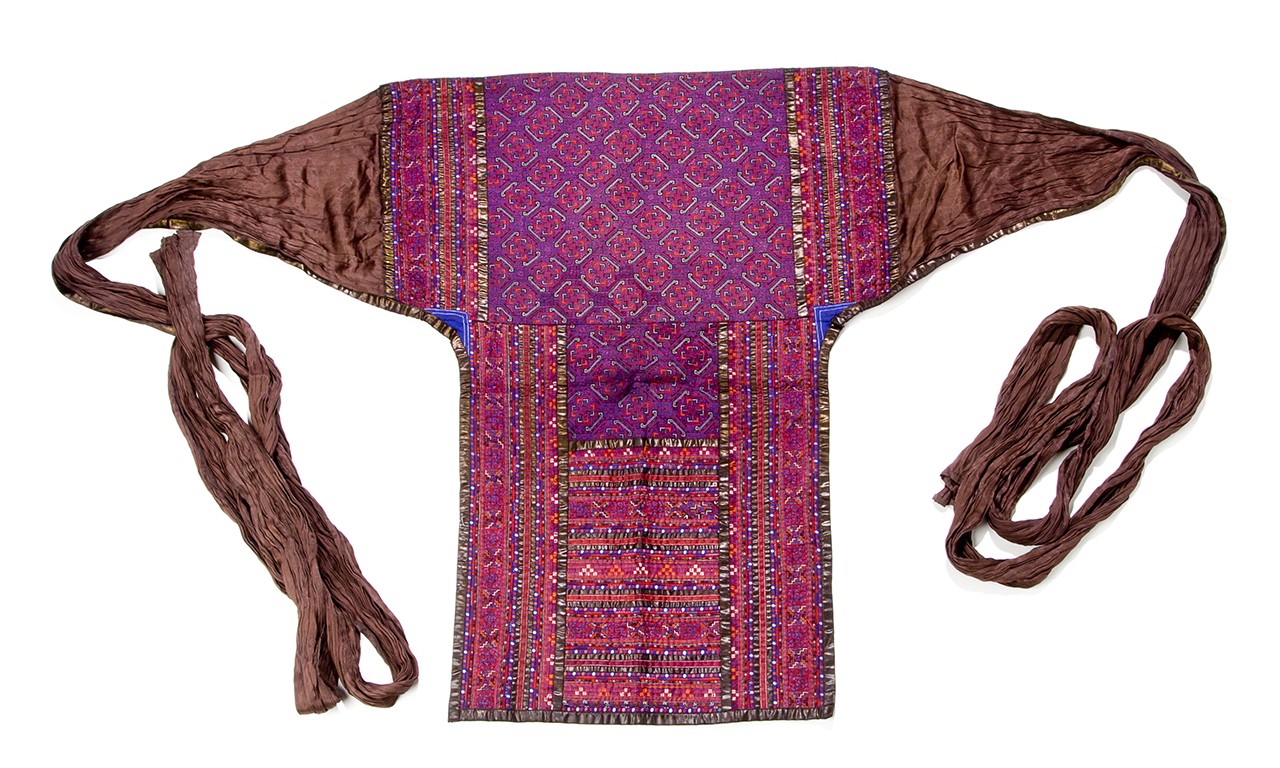 |
Baby Carrier with Pleated Ties, 20th Century
Miao culture; Gulong Town, Guizhou Province, China, Asia
Cotton and silk; 23 x 30 in.
2008.9.71
Gift of Anne and Long Shung Shih |
Miao Mom Weightlifting Club
We should be thankful to the wonderful moms in our lives every day, but Mother’s Day is the one day a year we have chosen to distill that love into the tangible forms of chocolates, flowers, trips to plant nurseries, our best, ultimately dubious home-cooked meals and more. Most don’t need any reminder as to why mothers are extraordinary, but this post nonetheless forges boldly ahead, looking at baby carriers used by Miao Chinese mothers of southeastern China. Very much an inspiration for modern baby-conveyance solutions—take Ergobaby™’s baby packs for instance—the broadly distributed, varied people umbrellaed by the name Miao are well known for making broad, varied baby carriers from cotton, silk and sometimes metal inclusions. In this Mother’s Day post, we look at a selection of the Bowers Museum’s most intricately embroidered carriers.

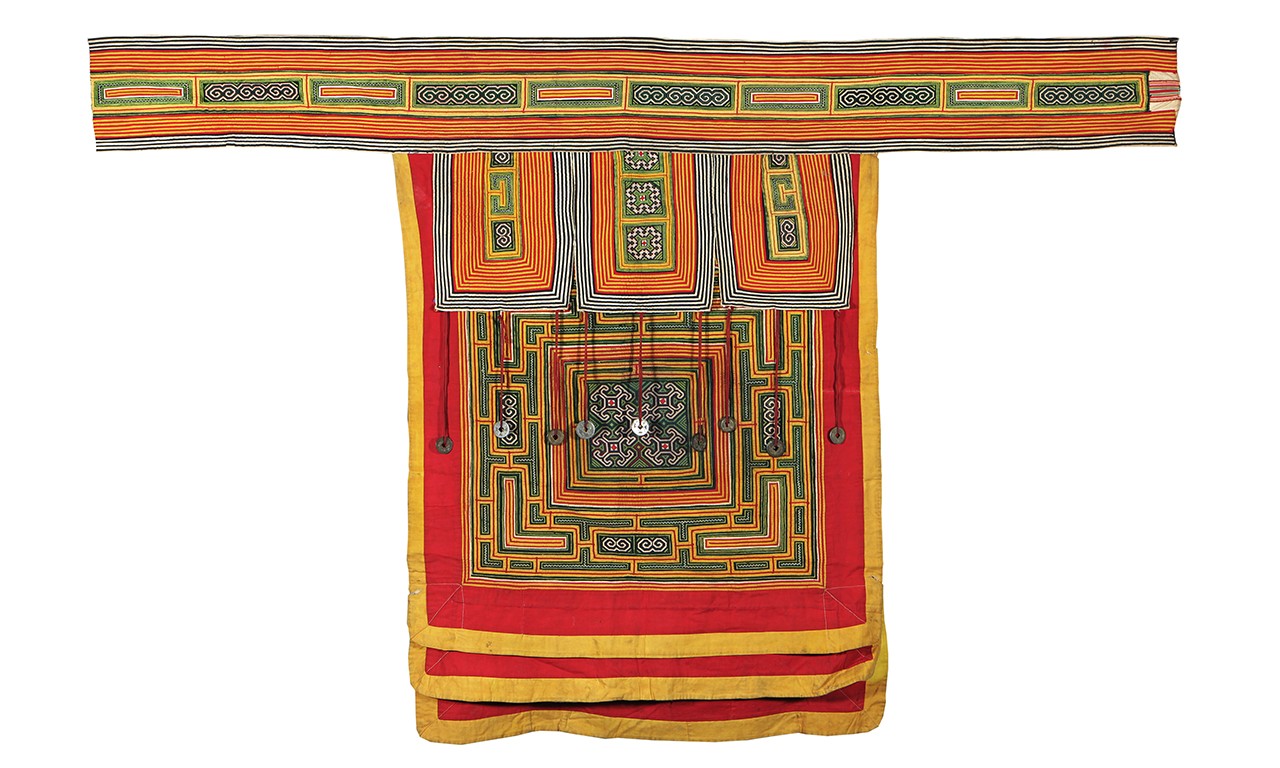 |
Baby Carrier with Attached Coins, mid to late 20th Century
Miao culture; Nankai Township, Qianxi County, Bijie Prefecture, Guizhou Province, China
Cotton, silk and coins; 36 × 56 in.
2015.9.31
Gift of Mr. and Mrs. Long Shung and Anne Shih |
Bring your Baby to Work Days
Miao culture has historically been agrarian, consisting of some herding, but mostly of rice farming. Day to day life involves strenuous work made all-the-more difficult by a lack of maternity leave—new mothers tend to do their daily work with their babies safely stowed on their backs in nondescript baby carriers. Miao festivals are an entirely different affair from the day to day lives of Miao women. There, intricate silverwork is worn in every imaginable way and highly ornate baby carriers such as the five featured in this post are always used. In fact, until infants are old enough to walk on their own, new mothers go everywhere with babies on their backs. The usage of carriers is ubiquitous enough that it has been associated to a post-natal umbilical cord between a mother and child. The time that goes into the creation of these textiles and the intricacy of their symbology seem to confirm this importance.

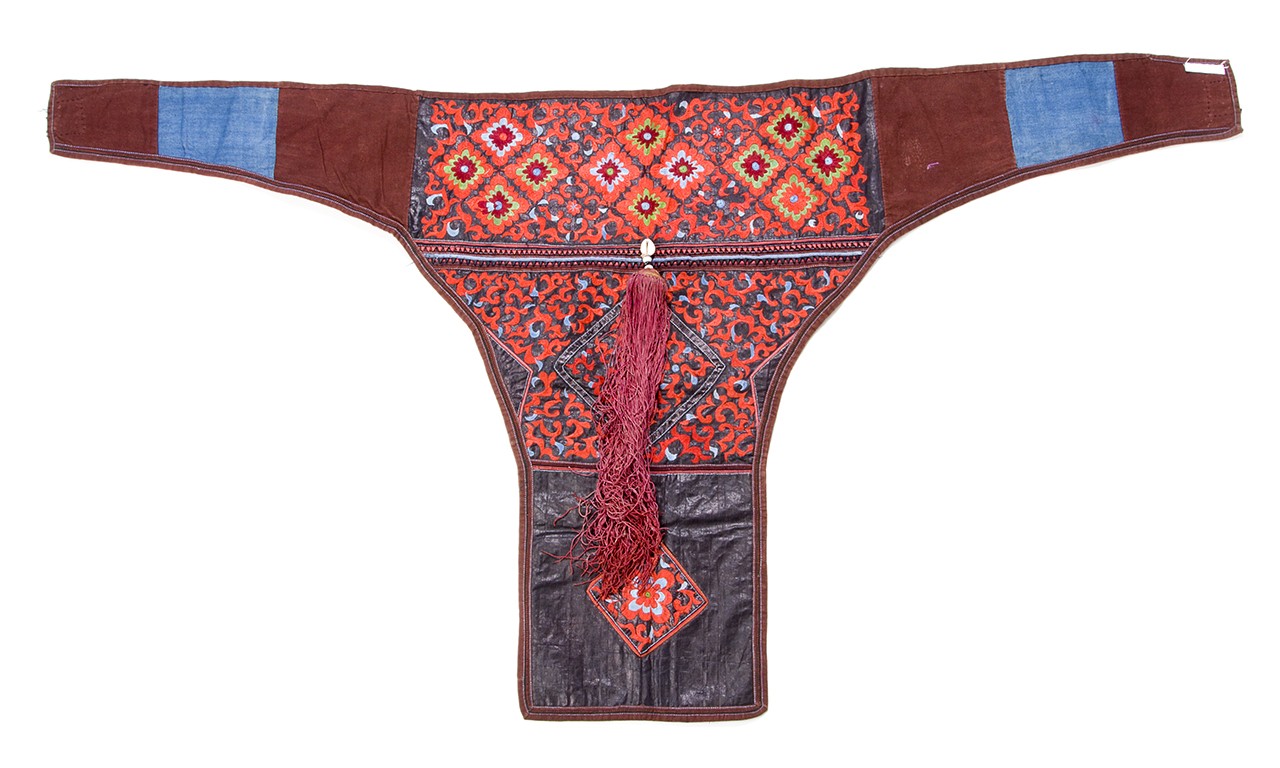 |
Baby Carrier, 20th Century
Raojia Yao culture; Majiang County, Guizhou Province, China
Cotton, shell and bead; 56 x 29 in.
2008.9.9
Gift of Anne and Long Shung Shih |
Marketable Skills
It takes an exorbitant amount of time to create a Miao baby carrier, the bulk of which is dedicated to embroidery. Despite their almost machine-like uniformity and symmetry, all this work is done by hand and requires immense concentration to carry out. The skill involved in the creation is made even more impressive by the facts that the designs are often not planned out in advance and that they tend to be done by girls and young, unmarried women—not master embroiderers with a lifetime of experience. Among some Miao groups baby carriers are instead made by a new mother’s family and presented to a her and her husband after a baby is one month old. A woman’s ability to create fine embroidery and textile work is seen as valuable to the community and especially to potential husbands and in-laws. Baby carriers and other embroidered work becomes part of a woman’s dowry.

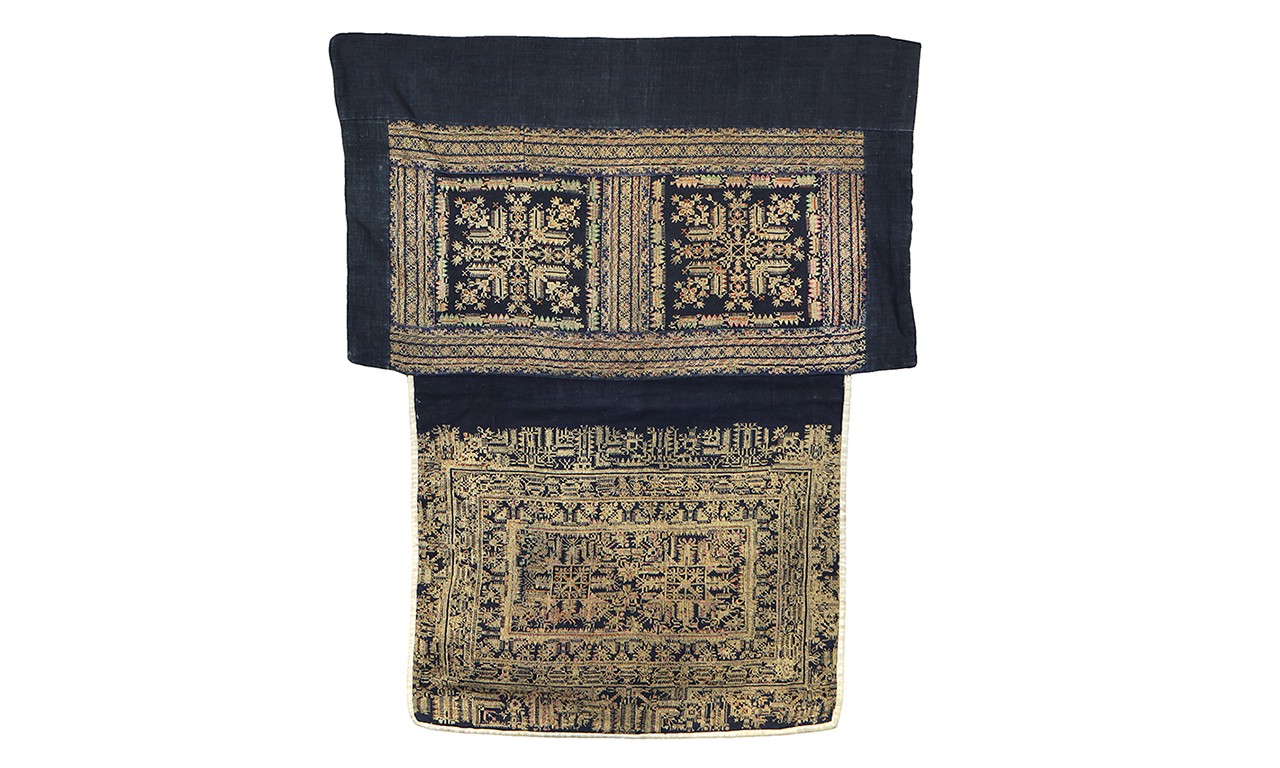 |
Baby Carrier, 20th Century
Miao culture; Huaxi District, Quinyang City Prefecture, Guizhou Province, China
Cotton and silk; 23 × 19 in.
2016.13.6
Gift of Mr. and Mrs. Long Shung and Anne Shih |
Home is Where the Baby Carrier Motifs Are
The incredible attention to detail in Miao embroidery allows for the inclusion of a complex assortment of motifs. Most of these are geometric stylizations of floral, zoomorphic, or religious subjects, though contact with Han Chinese has influenced the style of Northern Miao groups to the point that their embroidery work is considerably more naturalistic. Perhaps the two most pervasive motifs that decorate Miao baby carriers are the ancestral homelands and the mother butterfly. The Miao’s heritage is that of migration from east to west. Most often depicted as the above series of concentric rectangles just below two- or three-square designs, these are the ancestral cities of the Miao. The mother butterfly on the other hand was a guardian deity of the Miao. Shown sometimes as a regular butterfly and sometimes as having a face, either a naturalistic or stylized version of this design can be found on most Miao baby carriers.

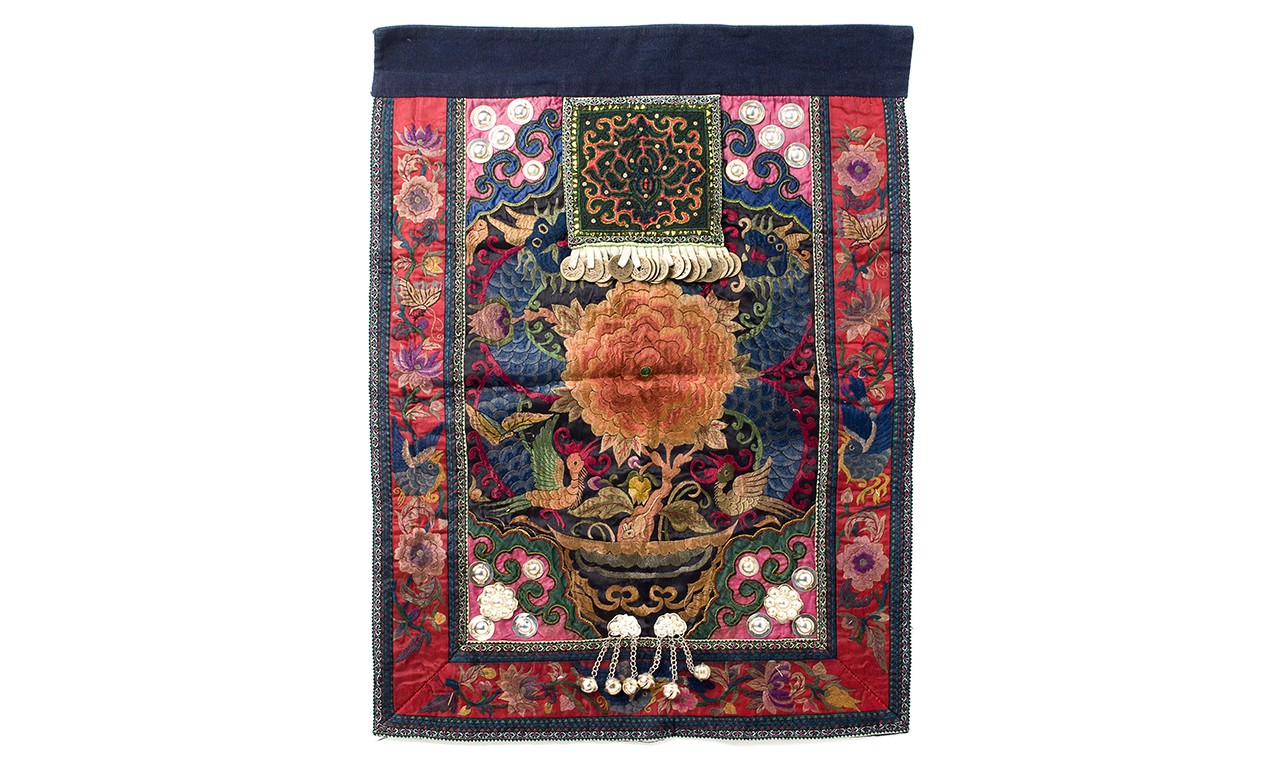 |
Baby Carrier Panel, 20th Century
Miao culture; Taigon Village, Taijiang County, Guizhou Province, China
Silk, cotton and metal; 20 1/2 x 27 15/16 in.
2007.15.7
Gift of Anne and Long Shung Shih |
Never Strapped for Cash
Many of the baby carriers in the Bowers Collections are missing the straps which would have once tied these elaborate panels to a woman’s body. Within Miao culture these straps hold a complex meaning, but it is generally explained that their regular usage causes them to absorb some the essence of the child. To part with the straps would be to break with the longstanding continuity of a family’s baby carrier, so when the carriers are retired, the straps are often cut off so that they can be attached to the next carrier a family uses. Similar rationale is employed in other inclusions. The Qing Dynasty coins attached at the center are tokens to ward off evil and ensure the good health of the baby it holds. As a final symbolic addition, the embroidery needle used to create the carrier is often incorporated into the product as a symbolic way of protecting one’s child.

Wherever you might be this Mother’s Day, be sure to show your love for your mom. Even if she didn’t do any farm work with you on her back she did without a doubt carry you and you were probably heavier than she cares to admit!
Additional information offered by Philippe Fatin. Text and images may be under copyright. Please contact Collection Department for permission to use. References are available on request. Information subject to change upon further research.







Comments 1
The third baby carrier come from the town of Majiang, guizhou province, belong to a sub group of Yao call Raojia.
The last one belong to the Miao of Taigon village , Taijiang district, guizhou.
See my book for further information :tribal textiles from southwestern China, threads from misty lands , river books.
Best regards